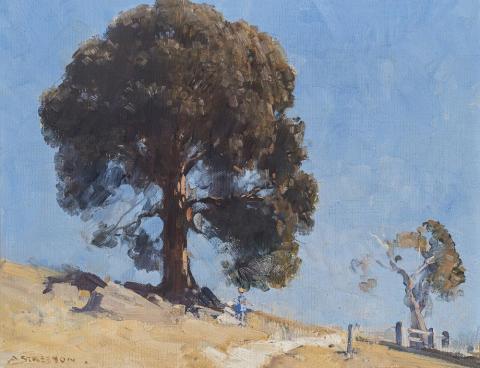SHEOAK, 1928
ARTHUR STREETON
oil on canvas
35.5 x 46.0 cm
signed lower left: A. STREETON
Macquarie Galleries, Sydney
Mr Robert Copeland Lethbridge, Bowral, New South Wales
Thence by descent
Mrs Ruby Lethbridge (née Simpson), Sydney, his widow
Thence by descent
Mrs Gwendolyn Barriskill (née Simpson), Sydney, her niece
Private collection, Sydney (a wedding gift from the above, the bride’s mother)
Possibly Exhibition of Paintings by Australian Artists, Fine Art Society’s Gallery, Melbourne, 25 October – 10 November, 1928, cat. 59
Recent Paintings Arthur Streeton, Macquarie Galleries, Sydney, 4 – 11 April 1929, cat. 11
Streeton, A., The Arthur Streeton Catalogue, Melbourne, 1935, cat. 986, p. 138 (as ‘The She-oak’, 1928, oil, 18 x 14, in the possession of Mr R.C. Lethbridge)
Trees are central to Arthur Streeton’s art. Even in England he painted the mighty oak. But it was Australian native trees in all their grandeur and many varieties that filled most of his canvases, evoking a nobility that inspired nationalism and spoke of the resilience of the Australian character. In his youth Streeton invested them with a romantic lyricism, as in the slender gums rising upwards over the young lovers in Above Us the Great Grave Sky, 1890. While in that same year The Selector’s Hut: Whelan on the Log, 1890, gum trees and pioneering endeavour cohabit a quite different work. (Both paintings are in the collection of the National Gallery of Australia, Canberra.) In later, panoramic landscapes as the Land of the Golden Fleece, 1926 (National Gallery of Victoria) Australian native trees people the broad expanses, being as much a part of the iconic scene as the sun baked land of grazing sheep and blue hills. Having settled at Olinda in the Dandenong Ranges in the twenties, the keen conservationist comes more to the fore. In the poignant Last of the Messmates, 1928, (private collection) the giants are now fallen, being one of several essays in the destruction of the messmate gums. And in A Mountain Side, 1935 (Westpac Banking Corporation) the mighty trunks brought low dominate the foreground in solemn silence.
Streeton loved native trees for themselves as well as what they stood for in aesthetic and nationalistic terms. Sheoak, 1928, is set in profile on the edge of an ascending slope, with a second tree placed more distant and smaller, as if to emphasise by contrast the majesty of the other. Striking in its composition, the light-filled landscape and short shadows of noontide invite the eye along the track to the horizon’s edge. When Streeton held his solo exhibition at the Fine Art Society’s Galleries in Melbourne in March 1928, his painting Sunlight Impression caught the critic’s eye, describing it as ‘One of the best things in the show … . Here the painter is most successful in rendering the heat of a hillside, with trees and rocks, against one of those blue skies that appear at times in the summer heat to be darker than the rest of the landscape’.1 The similarity to our painting indicates Streeton’s fascination with the motif.
These were vintage years for Streeton, who, at the height of his fame, was awarded the 1928 Wynne Prize for his painting Afternoon Light, Goulburn Valley, Victoria, 1927, (National Gallery of Australia). In 1931, he was further honoured by the Art Gallery of New South Wales with a loan exhibition of his works, and Art in Australia published the ‘Arthur Streeton Number’ in October of the same year. His solo exhibitions were numerous and successful, as our painting shows.
1. ‘Mr. Streeton’s Landscapes’, Age, Melbourne, 15 March 1928, p. 13
DAVID THOMAS
